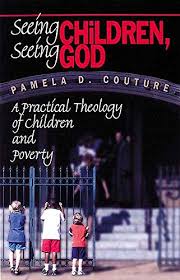Seeing Children, Seeing God: A Practical Theology of Children and Poverty

Review for Child Theology Movement Web page. 21.09.2017
Couture, Pamela. Seeing Children, Seeing God: A Practical Theology of Children and Poverty. Nashville, TN: Abingdon Press, 2000.
In the forward and introduction , Pamela Couture's study is described a response to the need for a holistic theology and praxis that incorporates the reality of poverty and the plight of children as integral to the church's theology and practice, and as offering an ethical lens through which we can focus the general work of pastoral and practical theology.
The opening chapter of her study sets the study in the context of a global overview of children's poverty, helpfully discriminating between material poverty and what she terms, the poverty of tenuous connections. She argues for the importance of an appreciation of relational deprivation of children as it manifests itself in the widening social circles of parental care, neighbourhood realities and organizations and government policies and services and goes on to develop her theological reflections in relation to this social ecology.
As a minister of the Methodist tradition, the author lives and works alongside vulnerable children and it is from these theological and ministerial perspectives that she develops a compelling critique on the church's response to poverty. There is an authenticity, an experiential and emotional depth to her discussions which is grounded in her long personal and church-based commitment to and engagement with children in need, which resonates with Child Theology's insistence upon keeping the real child at its heart. The children in focus in her study are not the constructs of a particular theory of Child development or statistical analysis, but rather they are the children whose personalities and life experiences she has engaged with and who have brought their personal and social realities not only into the forum of her theological debate but also into the life of the church challenged to understand and experience Kingdom life with children in their midst.
She argues that the Wesleyan doctrine of the Means of Grace through acts of mercy and piety is particularly well suited to explore this theme, expressed as it was alongside Wesley's intense commitment to raise up small congregations of Christian people active in response to local social and spiritual need. In a memorable sentence, evocative of Jesus setting a child at his side in a response to his disciples self-absorbed discussion about personal greatness, she writes, When we practice the means of grace and seek the revelation of God in our works of mercy, religious experience is heightened as a means of intimacy with God. When such reconnection occurs, it brings vitality in personal devotion and public worship. Life becomes more vivid we may actually begin to sense what Jesus might have meant when he said that an alternative reality of God's reign is with us now. -Pg.58.
Seeing Children, Seeing God is a title that powerfully captures the potential of a missional theology and practice informed by the child-reception events in the Gospels. For myself, and in less than 150 pages, this book lives up to the aspirations expressed in its introduction and stands as one of the best examples I have encountered so far of the prophetic potential of Child Theology to constructively challenge and inform the missional praxis of the church in a poverty riven world.
Stuart Christine, Manchester, UK

